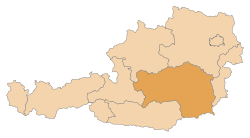Styria
| Styria Steiermark |
|||
|---|---|---|---|
| — State of Austria — | |||
|
|||
 |
|||
| Country | |||
| Capital | Graz | ||
| Government | |||
| - Governor | Franz Voves (SPÖ) | ||
| Area | |||
| - Total | 16,392 km2 (6,329 sq mi) | ||
| Population | |||
| - Total | 1,203,986 | ||
| - Density | 73.4/km2 (190.2/sq mi) | ||
| Time zone | CET (UTC+1) | ||
| - Summer (DST) | CEST (UTC+2) | ||
| ISO 3166 code | AT-6 | ||
| NUTS Region | AT2 | ||
| Votes in Bundesrat | 9 (of 62) | ||
| Website | www.verwaltung.steiermark.at | ||
Styria (German: Steiermark pronounced [ˈʃtaɪ.ɐmaʁk], Slovene: Štajerska, Prekmurian: Štájersko) is a state or Bundesland, located in the southeast of Austria. In area it is the second largest of the nine Austrian federal-states, covering 16,388 km². It borders Slovenia as well as the other Austrian states of Upper Austria, Lower Austria, Salzburg, Burgenland, and Carinthia. The population (as of 2006) was 1,203,986. The capital city is Graz.
Contents |
Geography
The term "Upper Styria" (German: Obersteiermark) used by an Austrian refers to the northern and northwestern parts of the federal-state (districts Liezen, Murau, Judenburg, Knittelfeld, Leoben, Bruck an der Mur, and Mürzzuschlag). The term "West Styria" (Weststeiermark) is used for the districts to the west of Graz (Voitsberg, Deutschlandsberg, western part of the district Leibnitz), the districts east of Graz (Weiz, Hartberg, Feldbach, Fürstenfeld, and Radkersburg) are referred to as "East Styria" (Oststeiermark). The western and eastern parts of the district Graz-Umgebung may or may not be considered parts of West and East Styria, respectively. The southern parts of the Duchy of Styria, which have formed part of Slovenia since 1918, were (and sometimes colloquially still are) referred to as "Lower Styria" (Untersteiermark; Slovene: Štajerska).
History
Economy
As elsewhere in the developed world, there has been a shift away from the manufacturing sector towards the service sector in Styria. This has had negative consequences for the industrial regions of upper Styria which have suffered a steady decline in population in recent years. In 2004 Styria had the strongest economic growth rate in Austria at 3.8% - mainly due to the Graz area which saw strong economic growth that year and has continued to grow in economic and population terms since then.
Administrative divisions
The state is divided into 16 districts (Bezirke), and a statutory city.

Statutory City
Districts
- Bruck an der Mur
- Deutschlandsberg
- Feldbach
- Fürstenfeld
- Graz-Umgebung
- Hartberg
- Judenburg
- Knittelfeld
- Leibnitz
- Leoben
- Liezen with the subdistricts
- Gröbming and Bad Aussee
- Mürzzuschlag
- Murau
- Radkersburg
- Voitsberg
- Weiz
Politics
The state had been a stronghold of the Austrian People's Party (ÖVP) since 1945. The governor (Austrian political term: Landeshauptmann) was usually a member of this party.
2005 Elections
In the latest elections for state parliament the Social Democrats (SPÖ) under their regional chairman Franz Voves won the majority after the ÖVP had damaged its credibility through scandals and the secession of a high-ranking party member who took part in the 2005 election after setting up his own party. In this election, the Communist Party (KPÖ) also received many votes after it had gained much popularity through its role in local politics in Graz during the preceding few years. The two right wing populist parties, the FPÖ and the BZÖ both failed to win seats.
Notable persons
- Frank Stronach (born 1932), founder of Magna International, billionaire
- Jochen Rindt (1942–1970), Formula 1 World Champion
- Dr. Helmut Marko (born 1943), former racing driver
- Dietrich Mateschitz (born 1944), founder and CEO of Red Bull, billionaire
- Klaus Maria Brandauer (born 1944), Austrian actor and director
- Elfriede Jelinek (born 1946), Nobel Prize in Literature winner
- Arnold Schwarzenegger (born 1947), Hollywood actor and Governor of California
- Thomas Muster (born 1967), former World No. 1 tennis player
- Renate Götschl (born 1975) Alpine skiing World Champion
- Elisabeth Görgl (born 1981) professional alpine skier
- Ulla Weigerstorfer (born 1967), Miss Austria and Miss World 1987
- Peter Rosegger (born 1843), Austrian poet
- Andreas Munzer (born 1966, died 1996), Professional Bodybuilder.
- Johann Puch, (slovene: Janez Puh, b. 1862 in Juršinci, Slovenia, died 1914), founded Johann Puch Erste Steiermärkische Fahrrad-Fabriks-Aktiengesellschaft at Graz in 1899.
- Johann Joseph Fux (born 1660 - died 1741), composer and music theorist, wrote Gradus ad Parnassum - a composition manual used by many famous composers including Beethoven and Mozart.
See also
External links
- Imperial Austria: Treasures of Art, Arms and Armor from the State of Styria - The Canadian Museum of Civilization
- Styrians
- Official Tourism Website of Styria
|
|||||
|
||||||||||
.svg.png)

